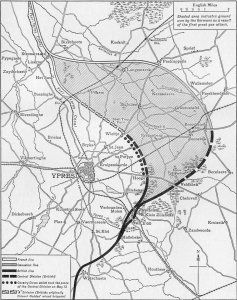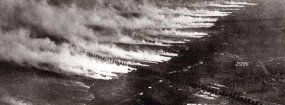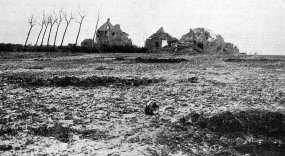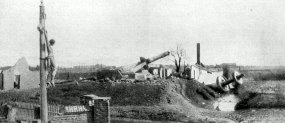
WWII: Maginot Line | Normandy | V-Weapon Sites | Arnhem
Further afield: Crete
| Home Tracing Military Ancestors Travel Advice CWGC Cemeteries Iron Harvest News Book Reviews Glossary Links Contact Me Ypres:
 
|
The Second Battle of Ypres (April to June 1915)The battle opened on 14th April 1915 with a massive German bombardment of Ypres which continued for nearly a month, destroying what was left of the town (Tour Guide - Ramparts CWGC, Ieper) However, it was what happened on the afternoon of 22 April to the north of Ypres, along the Pilckem Ridge, that made the headlines – the first concerted poison gas attack on the Western Front. The Germans released gas from up to 6,000 cylinders. The gas was chlorine and, as the coloured cloud enveloped the allied trenches, soldiers began to struggle to breathe. French Territorial and Algerian Divisions were in the path of the majority of the gas. As it entered their dugouts, they panicked. Soldiers began to stream away from their trenches to find some respite from this silent killer. It left a gaping hole in the front line. The road to Ypres lay open! Incredibly, however, the Germans only intended to take the Pilckem Ridge, and did not press their advantage. During the night, British reinforcements were rushed in to fill the breach and, together with the 1st Canadian Division, they held a second German gas attack on the 24th between St Julien and Passchendaele (Tour Guide – Vancouver Corner). The fighting continued into May by which time a further 60,000 British Empire, 10,000 French and 35,000 German troops had become casualties. For the rest of 1915 right up until June 1917, the front line remained fairly static. The main fighting on the Western Front had moved southwards to the Somme, Champagne and Verdun. But it would be a mistake to assume that the Ypres Salient was quiet. German artillery continued to range in on the town and its surroundings and British and Germans vied to best position themselves on the high ground. A further development occurred on the Menin Road on 29th July 1915 when the Germans used liquid fire for the first time to drive the British from their trenches (Tour Guide – Hooge). Heavy fighting also took place in and around Sanctuary Wood in 1916 where the Canadian Corps captured Hill 62, stemming a German advance in that area. |



